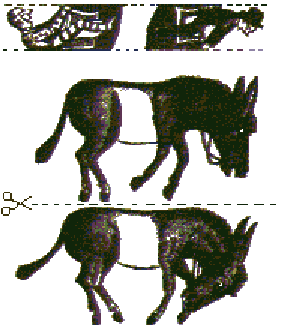 |
[HOME - BASE Cinque - Appunti di Matematica ricreativa]
Questo è un piccolo gioiello!
 |
Nella figura qui sopra si vedono due muli e due fantini.
Stampatela su un foglio di carta e tagliatela in tre strisce seguendo le
linee tratteggiate.
Fatto questo potete cominciare a risolvere il puzzle.
Lo scopo è quello di sistemare le tre strisce di carta in modo che ciascun
fantino sia seduto perfettamente a cavallo di un mulo.
Non si può tagliare la striscia dei fantini.
I fantini devono cavalcare nella direzione corretta.
Ultimo aggiornamento: gennaio 2004
Passo 1
Sistemate i due fantini e i due muli così.
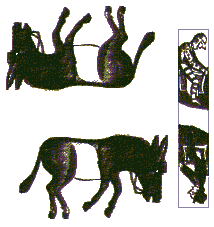
Non vi basta? Guardate sotto.
Passo 2
Mettete la striscia contenente i fantini orizzontalmente fra i due
muli.
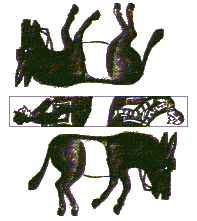
Non vi basta? Guardate sotto.
Passo 3
Avvicinate i muli l'uno verso l'altro.
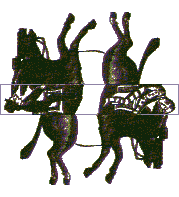
Non vi basta ancora? Guardate sotto.
Così va meglio?

Però... Samuel Loyd era un gran simpaticone!
Qualcuno sa costruire un puzzle simile a
questo, ma un po' più moderno,
ad esempio con le motociclette?
Un puzzle come questo è stato realizzato da Samuel Loyd nel 1871 ma le sue origini risalgono almeno al 1470.
By 1870 Loyd had become more interested in composing
mathematical puzzles than chess problems. He had composed a famous problem
consisting of three cards, two with the picture of a horse and the third with
a picture of two jockeys. The puzzle was to rearrange the pieces so that the
jockeys were riding the horses. He sold it to the showman P T Barnum and it
became famous as P T Barnum's Trick Donkey.
(Article by: J J O'Connor and E F
Robertson)
Loyd. P. T. Barnum's Trick Ponies. 1871. Loyd registered this in 1871 and sold it to Barnum shortly thereafter. See S&B, p. 34, for an illustration of Barnum's version. See SLAHP: Out for a gallop, pp. 65 & 110.
Mel Stover. 1980s?? Trick zebras puzzle. This has two identical cards with two zebras and two riders. The instructions say to cut one card into three parts along the dotted lines and put the riders on the zebras. However, one zebra is facing the opposite way to the usual case and it takes some time to realise how to solve the problem.
Apes on a horse. Paper toy from an Ulm woodcut, 1470. Reproduced in: Jasia Reichardt, ed.; Play Orbit [catalogue of an exhibition at the ICA, London, and elsewhere in 1969-1970]; Studio International, 1969, p. 45. This has two figures with a small bit of paper on a pivot which shifts the mid-body connections so either head is connected to either legs. No further description given by Reichardt and she says it was found by a research assistant, probably at the V&A.
Rza Abbasi (1587-1628). Drawing: Four Horses. Drawing given in: Kh. S. Mamedov; Crystallographic Patterns. Comp. & Maths. with Appls. 12B:1/2 (1986) [= I. Hargittai, ed., Symmetry _ Unifying Human Understanding, as noted in 6.G.] 511-529, esp. 525-526. Two heads and four bodies. This seems to be an outline made from the original, probably by Mamedov? See below for a possible original version.
Note storiche storiche del prof. David Singmaster
Nell'ultima nota, David Singmaster cita un disegno in cui compaiono 2
teste e 4 corpi di cavalli.
Ecco un esempio simile con 4 teste e 12 corpi.
E' dipinto su un piatto persiano del XVII secolo
(Fonte: Focus 103, maggio 2001)
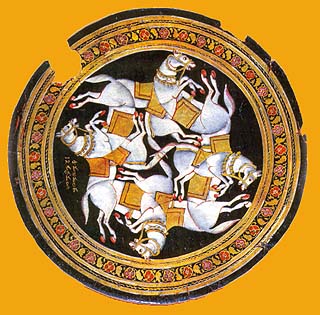
Un'altra immagine tratta da Martin Gardner.
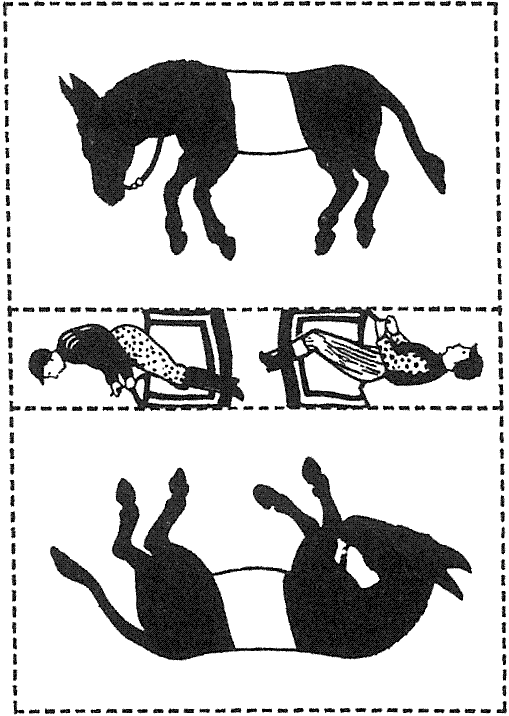
Sito Web realizzato da Gianfranco Bo